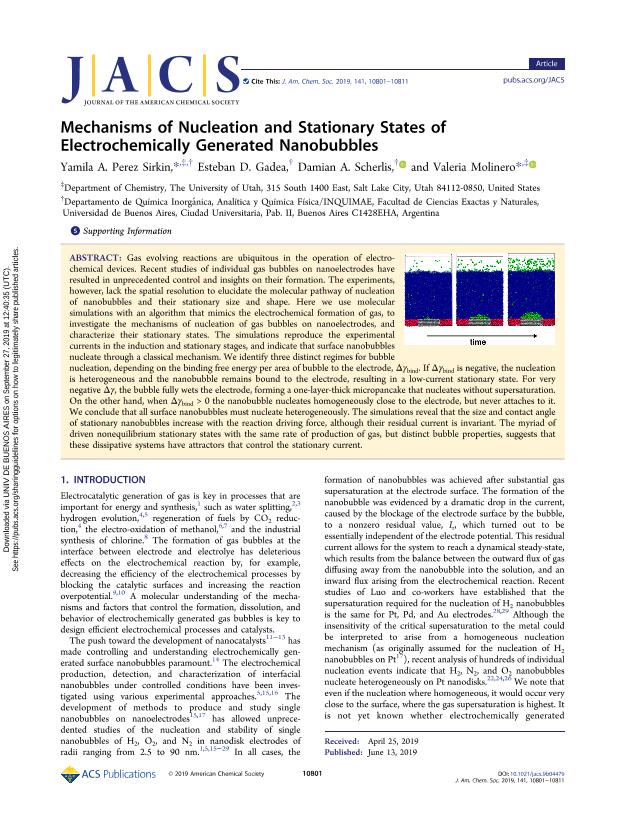Mostrar el registro sencillo del ítem
dc.contributor.author
Pérez Sirkin, Yamila Anahí

dc.contributor.author
Gadea, Esteban David

dc.contributor.author
Scherlis Perel, Damian Ariel

dc.contributor.author
Molinero, Valeria
dc.date.available
2021-01-07T12:52:53Z
dc.date.issued
2019-07
dc.identifier.citation
Pérez Sirkin, Yamila Anahí; Gadea, Esteban David; Scherlis Perel, Damian Ariel; Molinero, Valeria; Mechanisms of Nucleation and Stationary States of Electrochemically Generated Nanobubbles; American Chemical Society; Journal of the American Chemical Society; 141; 27; 7-2019; 10801-10811
dc.identifier.issn
0002-7863
dc.identifier.uri
http://hdl.handle.net/11336/121706
dc.description.abstract
Gas evolving reactions are ubiquitous in the operation of electrochemical devices. Recent studies of individual gas bubbles on nanoelectrodes have resulted in unprecedented control and insights on their formation. The experiments, however, lack the spatial resolution to elucidate the molecular pathway of nucleation of nanobubbles and their stationary size and shape. Here we use molecular simulations with an algorithm that mimics the electrochemical formation of gas, to investigate the mechanisms of nucleation of gas bubbles on nanoelectrodes, and characterize their stationary states. The simulations reproduce the experimental currents in the induction and stationary stages, and indicate that surface nanobubbles nucleate through a classical mechanism. We identify three distinct regimes for bubble nucleation, depending on the binding free energy per area of bubble to the electrode, ΔΓbind. If ΔΓbind is negative, the nucleation is heterogeneous and the nanobubble remains bound to the electrode, resulting in a low-current stationary state. For very negative ΔΓ, the bubble fully wets the electrode, forming a one-layer-thick micropancake that nucleates without supersaturation. On the other hand, when ΔΓbind > 0 the nanobubble nucleates homogeneously close to the electrode, but never attaches to it. We conclude that all surface nanobubbles must nucleate heterogeneously. The simulations reveal that the size and contact angle of stationary nanobubbles increase with the reaction driving force, although their residual current is invariant. The myriad of driven nonequilibrium stationary states with the same rate of production of gas, but distinct bubble properties, suggests that these dissipative systems have attractors that control the stationary current.
dc.format
application/pdf
dc.language.iso
eng
dc.publisher
American Chemical Society

dc.rights
info:eu-repo/semantics/openAccess
dc.rights.uri
https://creativecommons.org/licenses/by-nc-sa/2.5/ar/
dc.subject
NANOBUBBLES
dc.subject
CNT
dc.subject.classification
Química Inorgánica y Nuclear

dc.subject.classification
Ciencias Químicas

dc.subject.classification
CIENCIAS NATURALES Y EXACTAS

dc.title
Mechanisms of Nucleation and Stationary States of Electrochemically Generated Nanobubbles
dc.type
info:eu-repo/semantics/article
dc.type
info:ar-repo/semantics/artículo
dc.type
info:eu-repo/semantics/publishedVersion
dc.date.updated
2020-11-20T14:46:55Z
dc.identifier.eissn
1520-5126
dc.journal.volume
141
dc.journal.number
27
dc.journal.pagination
10801-10811
dc.journal.pais
Estados Unidos

dc.description.fil
Fil: Pérez Sirkin, Yamila Anahí. University of Utah; Estados Unidos. Consejo Nacional de Investigaciones Científicas y Técnicas. Oficina de Coordinación Administrativa Ciudad Universitaria. Instituto de Química, Física de los Materiales, Medioambiente y Energía. Universidad de Buenos Aires. Facultad de Ciencias Exactas y Naturales. Instituto de Química, Física de los Materiales, Medioambiente y Energía; Argentina
dc.description.fil
Fil: Gadea, Esteban David. Consejo Nacional de Investigaciones Científicas y Técnicas. Oficina de Coordinación Administrativa Ciudad Universitaria. Instituto de Química, Física de los Materiales, Medioambiente y Energía. Universidad de Buenos Aires. Facultad de Ciencias Exactas y Naturales. Instituto de Química, Física de los Materiales, Medioambiente y Energía; Argentina
dc.description.fil
Fil: Scherlis Perel, Damian Ariel. Consejo Nacional de Investigaciones Científicas y Técnicas. Oficina de Coordinación Administrativa Ciudad Universitaria. Instituto de Química, Física de los Materiales, Medioambiente y Energía. Universidad de Buenos Aires. Facultad de Ciencias Exactas y Naturales. Instituto de Química, Física de los Materiales, Medioambiente y Energía; Argentina
dc.description.fil
Fil: Molinero, Valeria. University of Utah; Estados Unidos
dc.journal.title
Journal of the American Chemical Society

dc.relation.alternativeid
info:eu-repo/semantics/altIdentifier/url/https://pubs.acs.org/doi/10.1021/jacs.9b04479
dc.relation.alternativeid
info:eu-repo/semantics/altIdentifier/doi/http://dx.doi.org/10.1021/jacs.9b04479
Archivos asociados
